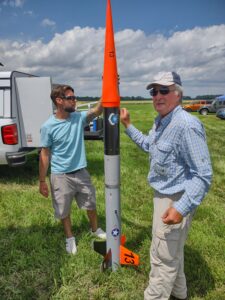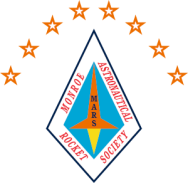High Power Rocketry, also known as HPR, is similar to model rocketry with differences that include the propulsion power and weight increase of the model. They use motors in ranges over “G” power and/or weigh more than laws and regulations allow for unrestricted model rockets.
High Power rocket motors cannot be purchased over the counter by the general consumer and typically are not carried by your average hobby store. They can be mail-ordered or purchased at some launch sites by adult modelers who are High power certified. HPR certification is a requirement to purchase and use these motors. The NAR offers a three level certification program for modelers who want to fly high power rockets. High power rockets must be flown in compliance with their own High Power Rocket Safety Code.
Who Regulates High Power Rocketry?
High power rockets fall under a code of regulations known as National Fire Protection Association (NFPA) Code 1127. The NFPA’s current rocketry codes were first written in 1995. Many states have adopted these codes by reference through their adoption of NFPA 1. Please check your state’s laws before attempting to launch high power rockets.
Where Is The Line Between Model and High Power Rocketry?
A rocket exceeds the definition of a model rocket under NFPA 1122 and becomes a High Power rocket under NFPA 1127 if it:
- Uses a motor with more than 160 Newton-seconds of total impulse (an “H” motor or larger) or multiple motors that all together exceed 320 Newton-seconds;
- Uses a motor with more than 80 Newtons average thrust (see rocket motor coding);
- Exceeds 125 grams of propellant;
- Uses a hybrid motor or a motor designed to emit sparks;
- Weighs more than 1,500 grams including motor(s); or
- Includes any airframe parts of ductile metal.
In addition, a rocket exceeds the definition of a model rocket under FAA rules (FAR 101.22) if weighs more than 1500 grams (53 ounces).
How do I get started in High Power Rocketry?

Tom McCarthy and his oldest son with Tom’s Nike
The NAR offers a three tier certification program for adult members who wish to build and fly high power rockets. Membership in the NAR empowers you to apply for HPR certification and NAR high power certification is free to all adult NAR members. The NAR has a Trained Safety Officer program, which is designed to assist individuals in performing safety officer functions on a high power rocket range. A complete set of technical reports regarding high power rocketry topics is available.
Junior HPR Participation Program
The Junior HPR Participation Program is offered to Junior and Leader members ages 14 – 17 in order that they may fly rockets using H and I class motors. The program follows the same basic procedure used for the HPR certification for Senior NAR members. However due to legal restrictions pertaining to the purchase and possession of high power rocket motors, ejection charges and related items, there are additional requirements.
Junior HPR Participation Program Procedure
Junior HPR Participation Program Application
HPR Level 1 Certification
HPR Level 1 Certification allows the purchase and use of H and I impulse class motors, both solid and hybrid. Certain F and G motors require Level 1 certification for purchase and use, This includes: hybrid motors, motors designed to emit sparks, motors that exceed 80 Newtons average thrust, motors containing 125 or more grams of propellant, or are in rockets weighing more than 1500 grams.
HPR Level 1 Certification Procedure
HPR Level 1 High Power Certification Application
HPR Level 2 Certification
HPR Level 2 Certification allows the purchase and use of J, K, and L impulse class motors.
HPR Level 2 Certification Procedure
HPR Level 2 High Power Certification Application
HPR Level 2 Written Exam Study Guide
HPR Level 2 On-Line Practice tests: Section A Section B Section C Section D Section E
HPR Level 3 Certification
HPR Level 3 Certification allows the purchase and use of M, N, and O impulse class motors.
HPR Level 3 Certification Procedure
HPR Level 3 High Power Certification Application

